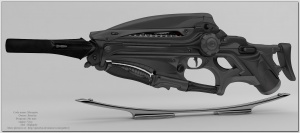Light Infantry Battle Rifle: Difference between revisions
Asid Mjolnir (talk | contribs) m (1 revision imported) |
Asid Mjolnir (talk | contribs) mNo edit summary |
||
| (One intermediate revision by the same user not shown) | |||
| Line 6: | Line 6: | ||
|variants = | |variants = | ||
|weight = 7.25Lbs/3.28 Kg (Fully Loaded) | |weight = 7.25Lbs/3.28 Kg (Fully Loaded) | ||
|length = | |length = | ||
|barrellength = 19in | |barrellength = 19in | ||
|cartridge = | |cartridge = | ||
| Line 31: | Line 31: | ||
==History== | ==History== | ||
The LIBR was designed in the later | The LIBR was designed in the later half of the [[War of Secession]] to be issued to strike teams that could ill-afford the bulkiness of the [[Mark I Battle Rifle|MIBR]]. Because of it's popularity and cost-efficiency, the LIBR was mass produced for use by light infantry, special forces, and irregular armed forces. It was deemed a restricted item and barred from civilian ownership along with other, similar, magnetic accelerator weapons. | ||
==Credit== | ==Credit== | ||
Latest revision as of 05:47, 20 July 2020
| Light Infantry Battle Rifle | |
|---|---|
 | |
| Specifications | |
| Designation: | Mark II Battle Rifle |
| Weight: | 7.25Lbs/3.28 Kg (Fully Loaded) |
| Barrel Length: | 19in |
| Rate of Fire: | 1,000 rounds/minute |
| Muzzle Velocity: | Variable (Setting Dependent) |
| Effective Range: | Variable (Setting Dependent) |
- For other weapons in the Battle Rifle family, see Mark I Battle Rifle.
The Light Infantry Battle Rifle (LIBR), occasionally known as the Mark II Battle Rifle (MIIBR / M2BR), is fielded by the armed forces of The Initiative, most commonly utilized by the Civil Defense Forces, and Colonial Security Force.
Design Details
The Light Infantry Battle Rifle is a light coilgun utilizing electromagnetic coils to draw a projectile down the barrel of the weapon. Initial models were locked to a single power setting, while later models had this restriction removed, with the user able to control the firing power either through set of manual dials or via a Neural Interface. Because the LIBR utilizes electromagnets, it is capable of being used across almost any battlefield, regardless of the atmosphere.
The LIBR was designed as a lighter version of the Mark I Battle Rifle (MIBR) to be issued to special forces, as well as civil defense forces and similar irregular forces operating within the Initiative's territory. Because of this, the LIBR's power pack is not as robust as that of the MIBR, and is home to a simpler version of the equipment used to interface with an Armored Exo-Suit to cut down on the weight and cost. The power pack is house in a sealed compartment in the stock, requiring the operator to carry additional batteries as part of their loadout.
Features
In addition to being able to be controlled by a Neural Interface, the LIBR is capable of sending targeting data, ammo status, and current power levels to an Armored Exo-Suit. The LIBR was designed with a number of electronic and physical safety lockouts to prevent it from firing on friendly forces, or being discharged in select spaces above a certain power level (such as aboard a space vessel). The LIBR is not outfitted with a palm reader, to allow it to be utilized by irregular military forces as needed.
The LIBR's surface has a number of hardpoints and rails to allow additional modules to be attached, such as scopes, tactical flaslights, targeting lasers, and bipods.
Materials
The LIBR is constructed from high-strength synthetic polymers, to minimize the weight, and chances of being detected on a metal scanner, as well as to maximize durability. The majority of the metal in the LIBR is in the circuitry for the firing computer, as well as in the electromagnetic coils.
History
The LIBR was designed in the later half of the War of Secession to be issued to strike teams that could ill-afford the bulkiness of the MIBR. Because of it's popularity and cost-efficiency, the LIBR was mass produced for use by light infantry, special forces, and irregular armed forces. It was deemed a restricted item and barred from civilian ownership along with other, similar, magnetic accelerator weapons.
Credit
- Image Source: DeviantArt
- Image used with permission from PeterKu